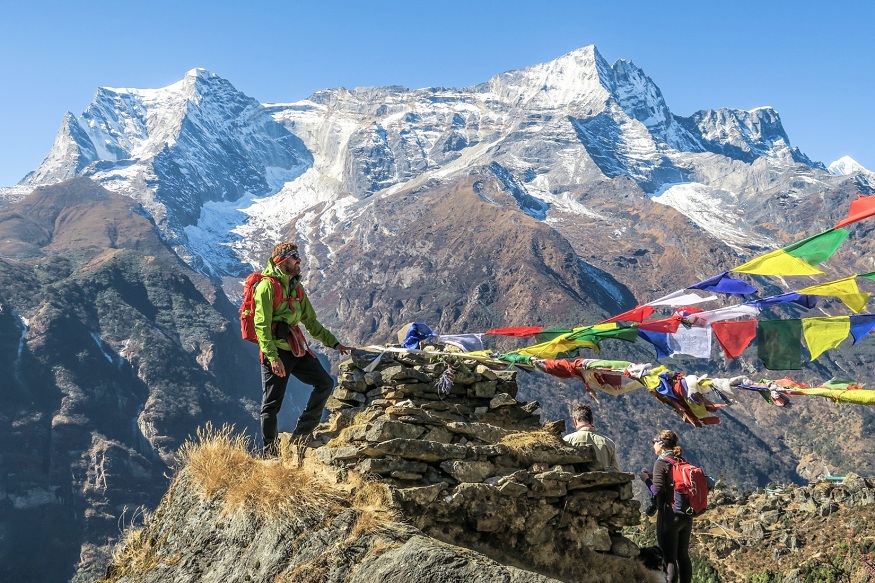The Ama Dablam Base Camp Trek is one of the most stunning and rewarding trekking routes in the Everest region of Nepal. Offering breathtaking views of the Himalayas, this trek takes adventurers to the base of the iconic Ama Dablam (6,812m), one of the most beautiful and technically challenging peaks in the world. Unlike the Everest Base Camp trek, this journey provides a more serene and off-the-beaten-path experience while still showcasing the grandeur of the Khumbu region.
Trek Overview
Duration: 7-12 days
Maximum Altitude: 4,570m (Ama Dablam Base Camp)
Difficulty Level: Moderate
Best Seasons: Spring (March-May) & Autumn (September-November)
Trekking Route
The trek to Ama Dablam climbing Base Camp usually begins in Lukla, a small town with an adventurous airstrip, known as the gateway to the Everest region. From Lukla, trekkers follow the classic Everest trail through picturesque Sherpa villages like Phakding and Namche Bazaar. Namche Bazaar, often called the ‘Sherpa Capital,’ serves as a vital acclimatization stop and offers excellent opportunities to explore the local culture and enjoy panoramic mountain views.
From Namche, the route deviates from the bustling Everest Base Camp trail, leading towards Pangboche, the highest permanent settlement in the region. This village is home to one of the oldest monasteries in the Khumbu region and provides a fascinating insight into Tibetan Buddhist traditions.
A final steep ascent through alpine meadows and rocky terrains brings trekkers to Ama Dablam Base Camp. The site offers an awe-inspiring up-close view of the mighty Ama Dablam, along with panoramic sights of Everest, Lhotse, Nuptse, and other Himalayan giants.
Climbing Ama Dablam: Key Information
Difficulty Level
- Technical Climb: Requires experience in rock, ice, and alpine climbing.
- Steep Terrain: Involves rock, ice, and mixed climbing.
- Exposure: There are sections with high exposure, including the famous Dablam (Hanging Glacier).
Duration & Cost
- Expedition Length: 25-30 days, including acclimatization and weather delays.
- Cost: Ranges from $6,000 to $15,000, depending on guides, logistics, and permits.
Permits Required
- Sagarmatha National Park Permit
- Nepal Climbing Permit (Approx. $400 per person in peak season)
Dangers & Risks
- Avalanches: From the hanging glacier near Camp 3.
- Altitude Sickness: AMS, HAPE, and HACE are concerns.
- Extreme Weather: High winds and freezing temperatures.
Guided or Independent Climb?
- Most climbers go with an expedition team (recommended).
- Independent climbs are possible but require strong logistical planning and mountaineering skills.
Maruntse Peak Climbing is an adventurous and challenging expedition in the Himalayas of Nepal. However, it seems like you might be referring to Mera Peak or Baruntse Peak, as “Maruntse” doesn’t appear to be a widely known climbing destination.
Here’s a breakdown of the two possible peaks you might be referring to:
Mera Peak Climbing (6,476m)
- Difficulty: Moderate (best for beginners)
- Location: Mahalangur section, Everest region, Nepal
- Duration: 18-20 days
- Best Season: Spring (March-May) & Autumn (September-November)
- Permit Required: Yes (climbing permit & national park entry)
- Route: Lukla → Paiya → Panggom → Kothe → Khare → High Camp → Summit
- Why Climb? Highest trekking peak in Nepal, offering breathtaking views of Everest, Lhotse, and Makalu.
Baruntse Peak Climbing (7,129m)
- Difficulty: Challenging (best for experienced climbers)
- Location: Makalu-Barun National Park, Nepal
- Duration: 25-30 days
- Best Season: Spring (March-May) & Autumn (September-November)
- Permit Required: Yes (climbing permit & national park entry)
- Route: Lukla → Mera Peak Base Camp → Baruntse Base Camp → Summit
- Why Climb? Technical climb with stunning panoramic views and an opportunity to experience the remote Barun Valley.
Would you like help planning your climb, or a

